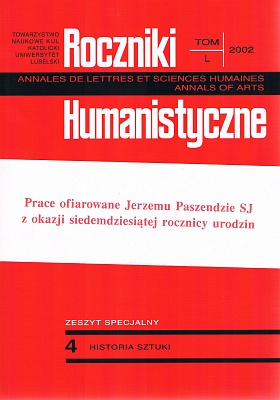Dekoracje kościoła jezuitów w Nysie
Abstrakt
The post-Jesuit church in Nysa, built in the years 1688-1690, is a three-span basilica with galleries, a narrower organ-loft span and two chapels on the sides of the presbytery. Initially the whole church interior was decorated with stuccoes. After the damages inflicted by the 1741 war and in 1751-1765 the stuccoes survived only on the column capitals and in the entablature of the presbytery and the nave, on the rood-screen arch and on the arch from the nave to the organ-loft. Decorations on the vaults of the side chapels survived – of the northern one – the Crucifiction chapel and of the southern one – the Guardian Angels chapel (now Jesus’ Heart chapel).
In the northern chapel the cross vault is cut with two strips of acanthus ornament with an oval area for a fresco painting, and on the western wall similar motifs of ‘wet’ acanthus form the frames of the fresco. In the southern chapel the decorations are more varied. Besides the ‘wet’ acanthus, motifs appear here of fruit and flowers hung on bands held by four eagles at the top of the vault, and on the entrance arch there are grapevines rendered in a veristic way. In the presbytery and the nave composite capitals and a twig of the ‘wet’ acanthus in the frieze of the entablature have survived as well as plant motifs in the arch spandrels formed in a different way in each span.
The frescoes were painted by Karol Dankwart of Nysa, which is confirmed in the sources. He worked for the Wrocław bishops; and also in Cracow, Poznań and Jasna Góra. However, the stucco painter is still unknown. We only know that Dankwart often co-operated with the stucco painter Bianchi whose Christian name was Giovanni or Adalbert. A comparison of the stuccoes that occur besides Dankwart’s painted decorations in the Jesuit church in Poznań or in the Jasna Góra basilica show beyond doubt that the decorations were made by the same hand.
I have already shown that Bianchi also co-operated with the architects Catenazzis from Wielkopolska. Friezes of twigs of ‘wet’ acanthus, identical as the ones in Nysa, occur in the Cistercian church in Przeme˛t, in the Leszno parish church, in the presbytery of the Phillipian church in Gostyń and in the Franciscan and Jesuit churches in Poznań . The decoration of the chapel dome in the Bernardine church in Ś wie˛ta Anna of probably 1695 done by Bianchi (in co-operation with Dankwart) is especially good. Giovanni Battista Bianchi vel Blanco is known in the literature to have worked in St. Florian in Austria in the years 1685-1686 and 1705- 1722, and also in Poland. In Silesia his first work was the decoration in Nysa (about 1689), then he decorated with ślinki a number of Polish churches and palaces (in Konarzew, 1699). In Polish literature he is sometimes mentioned with the wrong name – Adalbert, Wojciech, Alberto. The public register in Campione d’Italia says that ‘Joannes Baptista filius Mastri Dominici Biancho et Lucia” was born on 16 May 1659. His godfather was ‘Giacomo Guruvo of Bissone, a relative of Carlo Maderno coming from the well-known family of stone-masons and architects.
Copyright (c) 2002 Roczniki Humanistyczne

Utwór dostępny jest na licencji Creative Commons Uznanie autorstwa – Użycie niekomercyjne – Bez utworów zależnych 4.0 Międzynarodowe.





